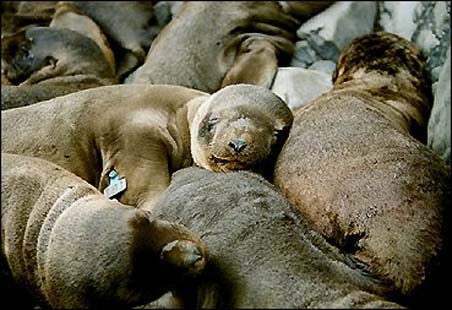Project Description
 The revised Steller sea lion Recovery Plan for 2008 includes the Russian/ Asian population of Steller sea lions as a region that must be considered in order for the stock to be downlisted or delisted. Thus, knowledge of sea lion demographics throughout the range is essential in understanding the dynamics of the species. Steller sea lion pups have been branded since 1996 on many rookeries in Russia, including Antsiferov, Brat Chirpoyev, Iony, Kozlov, Medney, Raykoke, Srednego, Lovushki, and Yamsky Islands. Brand/resight data is used to determine age/sex/cohort/rookery specific survival, as well as age at first reproduction and reproductive rates. This work was done by Contractors in a coordinated program with NMML and the Alaska SeaLife Center. Similar branding work is done in western Alaska, California and Oregon by NMML, and in SE Alaska by ADFG. By coordinating this work with that done by NMML and collaborators in North America, we can assess demographics across the entire range across years.
The revised Steller sea lion Recovery Plan for 2008 includes the Russian/ Asian population of Steller sea lions as a region that must be considered in order for the stock to be downlisted or delisted. Thus, knowledge of sea lion demographics throughout the range is essential in understanding the dynamics of the species. Steller sea lion pups have been branded since 1996 on many rookeries in Russia, including Antsiferov, Brat Chirpoyev, Iony, Kozlov, Medney, Raykoke, Srednego, Lovushki, and Yamsky Islands. Brand/resight data is used to determine age/sex/cohort/rookery specific survival, as well as age at first reproduction and reproductive rates. This work was done by Contractors in a coordinated program with NMML and the Alaska SeaLife Center. Similar branding work is done in western Alaska, California and Oregon by NMML, and in SE Alaska by ADFG. By coordinating this work with that done by NMML and collaborators in North America, we can assess demographics across the entire range across years.
The evaluation of Russian fishery management practices and their possible impact on Steller sea lions is a logical and necessary link to understanding the relation ships between fisheries and sea lion abundance in U.S. waters. This work includes the collection of new data, the analysis of existing and new data, the preparation of manuscripts, and field work in the Kuril Islands and Kamchatka.
Issues & Justification
The March 2008 Revised Steller Sea Lion Recovery Plan includes recovery criteria that incorporate trends of Steller sea lions in Russia. In order for this criteria to be met and Steller sea lions to be down listed from endangered, the population of Steller sea lions in Russia must be monitored. In addition, vital rates must be obtained to help determine the cause of the Steller sea lion decline in Alaska and Russia. These can only be obtained by following individual sea lions over long periods of time (longitudinal studies). Nutritional limitation and predation have been presented as hypotheses for changing sea lion survival or reproductive rates. Mark-recapture information is the best way to determine survival rates of the population by sex, age, region and cohort to determine which segment has been most affected by changing environmental conditions. Comparisons of life history data throughout the range are necessary to identify areas of concern. Performing this work in Russian waters is logistically and financially difficult and requires long term planning and strong relations with Russian scientists.
Goals
- Brand ~250 pups (total at all rookeries) per year in Russia depending on funding availability
- Establish field camps at some or all of the SSL rookeries in Russian waters.
- Conduct resight effort on dedicated cruises, during other ship or land-based field work (e.g., field camps)
- Cruise reports filed within 1 month after completion
- Field camp data available within 4 months after completion
Methods
In 1989, over 700 Steller sea lion pups were branded on 4 rookery islands in the Russian Kurils: Brat Chirpoyev, Lovushki, Srednego, and Raykoke. Branding activities started again in Russia in 1996 at Antsiferov, but were expanded to 7 rookeries in 1998. NMML branded a total of 800 pups at Marmot Island in 1987-88, then reinitiated branding studies in 2000 at Marmot and Sugarloaf Islands, in 2001 at Ugamak, Fish, and Seal Rocks in Alaska and at Rogue Reef, OR, and in 2002 at St George Island, CA. ADFG re-initiated branding studies in 2001 (after branding 799 pups on Forrester Island in 1994-95) in the range of the eastern stock at Forrester, Hazy, White Sisters and Graves Rock. All researchers in Alaska use the same techniques and marking. Pups are branded with individually identifiable numbers and letters on their left shoulder as pups then observed in subsequent years to determine vital rates. Observers are stationed at field camps on islands, and brand-resight effort also is done by ship-based personnel during the breeding season. During brand-resight cruises, numerous rookeries and haulouts are visited to look for branded animals and to collect scat for food habits analyses. Survival rates by sex, age, location and cohort will be estimated (along with the probability of resighting) using the program MARK.

